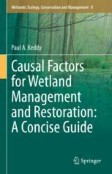Search
Search Results
-
Responses of three invasive alien aquatic plant species to climate warming and plant density
Climate warming may impact plant invasion success directly, as well as indirectly through changes among interactions within plant communities....

-
Regional habitat suitability for aquatic and terrestrial invasive plant species may expand or contract with climate change
The threat of invasive species to biodiversity and ecosystem structure is exacerbated by the increasingly concerning outlook of predicted climate...

-
Historical trends of aquatic invasive species introduction and establishment in Illinois, USA
Tracking the introduction and establishment of aquatic invasive species (AIS) is important for monitoring the biological and economic health of...

-
Predicting preferences for chemical treatment of aquatic invasive species and implications for outreach
The spread of aquatic invasive species (AIS) poses many challenges to local, state, and federal government agencies in the United States and...

-
Social and ecological drivers of behavior that prevents aquatic invasive species transport
Aquatic invasive species (AIS) have caused widespread damage to environmental and socio-economic systems across the globe. One vector of biological...

-
First record of the semi-aquatic invasive plant Crassula helmsii in the Iberian Peninsula and its link to potential dispersal drivers
Aquatic neophytes are among the most harmful invasive species worldwide. Here we report the finding of the semi-aquatic invasive plant Crassula helmsii ...

-
Ranking of Invasive Aquatic Species of Belarus by Their Impacts on the Basis of GISS (Generic Impact Scoring System)
AbstractComparative analysis of invasive aquatic animal impact was performed on the basis of GISS (Generic Impact Scoring System). Species ranking...

-
Invasive submerged plant has a stronger inhibitory effect on epiphytic algae than native plant
The invasion of submerged aquatic plants potentially results in a loss of native biodiversity in these ecosystems. There has been little attention...

-
Plant distribution and conservation in mediterranean islands’ lentic wetlands: there is more than aquatic species
This study investigates the distribution and conservation status of plant species in lentic wetlands of Mediterranean islands. Field data on vascular...

-
Management Approaches for Biological Control of Invasive Species
Invasive species significantly impact ecosystems, causing damage to plant species and billions of dollars in loss annually, hence requiring the...
-
The beneficial effect of barley straw extract addition on the growth of two aquatic invasive alien species (Elodea nuttallii and Cabomba caroliniana) under laboratory conditions
Barley straw has been used around the world for decades as a simple, cost-effective and harmless phytoplankton growth inhibition method. Although the...

-
Angler knowledge of live bait regulations and invasive species: insights for invasive species prevention
The prevention of aquatic invasive species is one of the most cost-effective management strategies for reducing negative ecological, economic, and...

-
Invasive Alien Species Problem in the Reservoir
This chapter discusses the issue of invasive alien species in the Three Gorges Reservoir (TGR), highlights different natural and anthropogenic...
-
Identifying opportunities for invasive species management: an empirical study of stakeholder perceptions and interest in invasive species
Invasive species are one of the main reasons for the decline in global biodiversity. When it comes to the management of invasive species,...

-
Plant Invasion in an Aquatic Ecosystem: A New Frontier Under Climate Change
Climate change and invasive species impose severe threats to biodiversity, ecosystem, and economy; however, the impact on human well-being and...
-
Simulated nitrogen deposition increased herbivore resistance and competitive ability of an invasive plant species over a native co-occurring congeneric species
Background and AimsThe deposition of atmospheric nitrogen has increased globally and interfered with plant growth and development. However, only a...

-
Application of environmental DNA analysis for detecting potential sources of invasive aquatic plant Egeria densa in a riverine network
Invasive aquatic plants can have various ecological impacts on river ecosystems. It is important to identify the spatial positions of the invasive...

-
Invasive Species Are an Emerging Causal Factor
Each ecoregionEcoregions has a group of species that naturally occur in wetlands. Invasive species introduced from other ecoregionsEcoregions can...
-
Aquatic Macrophytes and Wetlands
This chapter provides a definition of the wetland types where the aquatic macrophytes described in this Atlas occur. There are also wetlands where...
-
Diversity and environmental determinants of aquatic plants across China
Aquatic plants play an important role in aquatic systems. A comprehensive understanding of their spatial distribution may help to develop...

